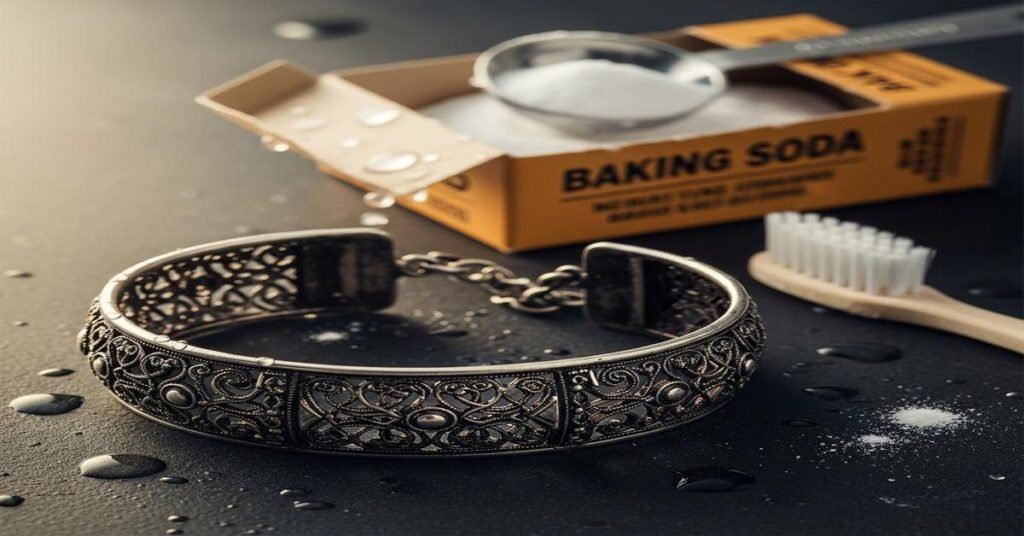Silver anklets turn black because silver reacts with sulfur and other chemicals in air, sweat and products. That black film is silver sulfide — not dirt — and it can be reversed. There’s a fast, cheap method that brings back bright silver almost instantly using one common household item: aluminum foil. Below I explain exactly why it works, how to do it safely for anklets, and when to avoid it.
Why silver turns black (and why foil fixes it)
Sterling silver is usually 92.5% silver and 7.5% copper (marked 925). Fine silver (99.9% Ag) tarnishes far less. Tarnish is a chemical change: silver atoms combine with sulfur to form dark silver sulfide (Ag2S). The aluminum-foil method uses a simple redox reaction. Aluminum is more reactive than silver. When your silver touches aluminum in hot, basic water, the sulfur atoms move from silver to aluminum. The silver is returned to metallic silver and the aluminum surface gets oxidized instead.
That’s why the method can clear tarnish quickly — it’s a chemical transfer, not just rubbing it off.
What you’ll need (and why)
- Aluminum foil — the one essential household item. It provides the reactive metal surface that accepts sulfur.
- Hot (near‑boiling) water — speeds the reaction by increasing molecular motion.
- Baking soda (sodium bicarbonate) — makes the solution basic. Basic conditions help the redox reaction proceed. Use about 1 tablespoon per cup (250 ml) of water.
- A heatproof bowl or sink lined with foil — the silver must directly touch the foil for the process to work.
- Soft cloth or microfiber for drying and light polishing.
Step-by-step: Clean silver anklets instantly
Follow these steps for chain anklets, charms and simple linked designs. If your anklet has stones, pearls, lacquer, or an intentional dark finish, see the precautions below first.
- Line the bottom of a heatproof bowl or the sink with aluminum foil, shiny side up. The foil must not be torn so it makes full contact with the silver.
- Place the anklet directly on the foil. Arrange links so as many surfaces touch the foil as possible. Close curved pieces will still benefit because the solution conducts across small gaps.
- Boil enough water to cover the piece. For a small bowl use 1 cup (250 ml); for a larger pot use 1 liter (4 cups).
- Add baking soda: about 1 tablespoon per cup (250 ml) of boiling water. Stir briefly to dissolve. You’ll see some fizzing — that’s normal.
- Pour the hot baking-soda solution over the anklet until fully submerged and touching the foil. You should see tiny bubbles and sometimes a faint gray residue lift off immediately.
- Wait 30 seconds to 3 minutes. Light tarnish often clears in under a minute. Heavier tarnish may take a few minutes. Don’t leave plated or delicate pieces soaking (see precautions).
- Remove the anklet with tongs, rinse under clean water, and dry thoroughly with a soft cloth. For crevices, gently brush with a soft toothbrush while rinsing.
- If any dark spots remain, repeat once more. For very stubborn tarnish, use a jeweler’s polishing cloth or take the piece to a professional.
Why this is safe for most sterling anklets — and when it’s not
The method is safe for solid sterling silver because it restores metallic silver without abrasion. But do not use it on:
- Silver-plated jewelry — the process can strip the thin silver plating and expose base metal.
- Pieces with glued stones or porous gems (pearls, opal, turquoise, coral) — hot water and the solution can loosen glue or damage the stone’s surface.
- Oxidized/antiqued finishes — many designs rely on a deliberate dark patina to show detail. The foil method will remove that patina and may ruin the intended look.
- Hinges, soldered clasps or very fragile links — prolonged soaking and handling can stress weak joins. Keep soak time short and handle gently.
Troubleshooting and troubleshooting examples
- If black residue clings in chain joints: after the foil soak, use a soft toothbrush and a baking-soda paste (1 part water to 2 parts baking soda) to work residues gently out. Rinse and dry.
- If the anklet looks dull after cleaning: polish with a soft jeweler’s cloth. Don’t use abrasive powders that can remove metal or plating.
- If tarnish returns quickly: check for copper-rich alloys or environmental causes. Copper content, perfumes, sweat (acidic), or sulfur-rich air accelerate tarnish.
Prevent tarnish: practical steps for anklets
Prevention is easier than repeated deep cleaning. Follow these practical tips:
- Wear your silver. Regular wear reduces tarnish because oils on your skin slow sulfur buildup. Rinse after heavy sweating.
- Store in airtight bags (zip-lock) with an anti‑tarnish strip or a small silica gel packet. Low humidity slows the reaction.
- Avoid contact with chlorine, bleach, cosmetics, and perfumes. Even salt water speeds corrosion of alloys.
- Remove anklets for swimming, showering, or lotion application. These expose silver to chemicals that accelerate tarnish.
When to call a professional
If an anklet is heavily pitted, solder joints are weakening, or gemstones are set, take it to a jeweler. Deep corrosion or loss of metal requires professional polishing or repair. A jeweler will also preserve intentional finishes and check clasps and solder points.
In short: aluminum foil plus hot baking-soda water is the fastest household way to restore sterling silver anklets because it reverses the chemical reaction that creates black tarnish. Use it carefully around stones, plated items, and oxidized finishes. Store pieces properly and wear them often to keep them bright.
I am G S Sachin, a gemologist with a Diploma in Polished Diamond Grading from KGK Academy, Jaipur. I love writing about jewelry, gems, and diamonds, and I share simple, honest reviews and easy buying tips on JewellersReviews.com to help you choose pieces you’ll love with confidence.

